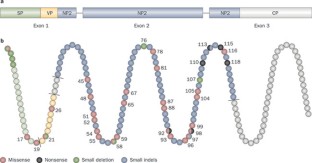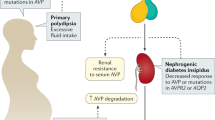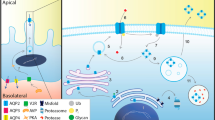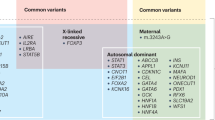Abstract
Over the past two decades, the genetic and molecular basis of familial forms of diabetes insipidus has been elucidated. Diabetes insipidus is a clinical syndrome characterized by the excretion of abnormally large volumes of diluted urine (polyuria) and increased fluid intake (polydipsia). The most common type of diabetes insipidus is caused by lack of the antidiuretic hormone arginine vasopressin (vasopressin), which is produced in the hypothalamus and secreted by the neurohypophysis. This type of diabetes insipidus is referred to here as neurohypophyseal diabetes insipidus. The syndrome can also result from resistance to the antidiuretic effects of vasopressin on the kidney, either at the level of the vasopressin 2 receptor or the aquaporin 2 water channel (which mediates the re-absorption of water from urine), and is referred to as renal or nephrogenic diabetes insipidus. Differentiation between these two types of diabetes insipidus and primary polydipsia can be difficult owing to the existence of partial as well as complete forms of vasopressin deficiency or resistance. Seven different familial forms of diabetes insipidus are known to exist. The clinical presentation, genetic basis and cellular mechanisms responsible for them vary considerably. This information has led to improved methods of differential diagnosis and could provide the basis of new forms of therapy.
Key Points
-
Diabetes insipidus is characterized by polyuria and polydipsia and caused by a deficiency in either the neurohypophyseal production or the renal action of the antidiuretic hormone arginine vasopressin (AVP)
-
The defects in AVP secretion or action are most commonly acquired as a result of various injuries or diseases but can also be idiopathic or genetic in origin
-
Genetic deficiencies of AVP production are caused by dominant mutations in the AVP gene or less commonly due to recessive mutations of the AVP, Wolframin or an X-linked gene
-
Genetic defects in AVP action are caused by recessive mutations in the X-linked AVP2 receptor gene or by recessive or dominant mutations of the gene for the aquaporin-2 water channel
-
The antidiuretic defects in both types of familial diabetes insipidus vary greatly in severity, which makes differential diagnosis by traditional indirect methods difficult in many patients
-
Desmopressin corrects diabetes insipidus caused by AVP deficiency, but is not useful in patients with defects in AVP action, who use other treatments that alleviate but rarely correct their disease
This is a preview of subscription content, access via your institution
Access options
Subscribe to this journal
Receive 12 print issues and online access
$209.00 per year
only $17.42 per issue
Buy this article
- Purchase on Springer Link
- Instant access to full article PDF
Prices may be subject to local taxes which are calculated during checkout








Similar content being viewed by others
References
Robertson, G. L. Antidiuretic hormone. Normal and disordered function. Endocrinol. Metab. Clin. North Am. 30, 671–694 (2001).
Gainer, H., Yamashita, M., Fields, R. L., House, S. B. & Rusnak, M. The magnocellular neuronal phenotype: cell-specific gene expression in the hypothalamo–neurohypophysial system. Prog. Brain Res. 139, 1–14 (2002).
Land, H. et al. Deduced amino acid sequence from the bovine oxytocin-neurophysin I precursor cDNA. Nature 302, 342–344 (1983).
Land, H., Schütz, G., Schmale, H. & Richter, D. Nucleotide sequence of cloned cDNA encoding bovine arginine vasopressin-neurophysinII precursor. Nature 295, 299–303 (1982).
Acher, R., Chauvet, J. & Rouille, Y. Dynamic processing of neuropeptides: sequential conformation shaping of neurohypophysial preprohormones during intraneuronal secretory transport. J. Mol. Neurosci. 18, 223–228 (2002).
de Bree, F. M. & Burbach, J. P. Structure-function relationships of the vasopressin prohormone domains. Cell. Mol. Neurobiol. 18, 173–191 (1998).
Robertson, G. L. Physiology of ADH secretion. Kidney Int. Suppl. 21, S20–S26 (1987).
Robertson, G. L., Shelton, R. L. & Athar, S. The osmoregulation of vasopressin. Kidney Int. 10, 25–37 (1976).
Zerbe, R. L. & Robertson, G. L. Osmoregulation of thirst and vasopressin secretion in human subjects: effects of various solutes. Am. J. Physiol. 244, E607–E614 (1983).
Baylis, P. H. Osmoregulation and control of vasopressin secretion in healthy humans. Am. J. Physiol. 253, R671–R678 (1987).
Koch, K. L. Nausea and vasopressin. Lancet 338, 1023 (1991).
Robertson, G. L. The use of vasopressin assays in physiology and pathophysiology. Semin. Nephrol. 14, 368–383 (1994).
Nonoguchi, H. et al. Immunohistochemical localization of V2 vasopressin receptor along the nephron and functional role of luminal V2 receptor in terminal inner medullary collecting ducts. J. Clin. Invest. 96, 1768–1778 (1995).
Birnbaumer, M. et al. Molecular cloning of the receptor for human antidiuretic hormone. Nature 357, 333–335 (1992).
Deen, P. M. et al. Requirement of human renal water channel aquaporin-2 for vasopressin-dependent concentration of urine. Science 264, 92–95 (1994).
Ward, D. T., Hammond, T. G. & Harris, H. W. Modulation of vasopressin-elicited water transport by trafficking of aquaporin2-containing vesicles. Annu. Rev. Physiol. 61, 683–697 (1999).
Fushimi, K., Sasaki, S. & Marumo, F. Phosphorylation of serine 256 is required for cAMP-dependent regulatory exocytosis of the aquaporin-2 water channel. J. Biol. Chem. 272, 14800–14804 (1997).
van Balkom, B. W. et al. The role of putative phosphorylation sites in the targeting and shuttling of the aquaporin-2 water channel. J. Biol. Chem. 277, 41473–41479 (2002).
Nielsen, S. et al. Aquaporins in the kidney: from molecules to medicine. Physiol. Rev. 82, 205–244 (2002).
Sasaki, S. et al. Cloning, characterization, and chromosomal mapping of human aquaporin of collecting duct. J. Clin. Invest. 93, 1250–1256 (1994).
Ishibashi, K. et al. Immunolocalization and effect of dehydration on AQP3, a basolateral water channel of kidney collecting ducts. Am. J. Physiol. 272, F235–F241 (1997).
Kim, S. W. et al. Decreased expression of AQP2 and AQP4 water channels and Na,K-ATPase in kidney collecting duct in AQP3 null mice. Biol. Cell 97, 765–778 (2005).
Gottschalk, C. W. & Mylle, M. Micropuncture study of the mammalian urinary concentrating mechanism: evidence for the countercurrent hypothesis. Am. J. Physiol. 196, 927–936 (1959).
Robertson, G. L. Diabetes insipidus. Endocrinol. Metab. Clin. North Am. 24, 549–572 (1995).
Robinson, A. G. DDAVP in the treatment of central diabetes insipidus. N. Engl. J. Med. 294, 507–511 (1976).
Weitzman, R. E. & Kleeman, C. R. The clinical physiology of water metabolism. Part II: Renal mechanisms for urinary concentration; diabetes insipidus. West J. Med. 131, 486–515 (1979).
Crawford, J. D. & Kennedy, G. C. Animal physiology: Chlorothiazide in diabetes insipidus. Nature 183, 891 (1959).
Brown, D., Hasler, U., Nunes, P., Bouley, R. & Lu, H. A. J. Phosphorylation events and the modulation of aquaporin 2 cell surface expression. Curr. Opin. Nephrol. Hypertens. 17, 491–498 (2008).
Aleksandrov, N. et al. Gestational diabetes insipidus: a review of an underdiagnosed condition. J. Obstet. Gynaecol. Can. 32, 225–231 (2010).
Robertson, G. L. Dipsogenic diabetes insipidus: a newly recognized syndrome caused by a selective defect in the osmoregulation of thirst. Trans. Assoc. Am. Physicians 100, 241–249 (1987).
Zerbe, R. L. & Robertson, G. L. A comparison of plasma vasopressin measurements with a standard indirect test in the differential diagnosis of polyuria. N. Engl. J. Med. 305, 1539–1546 (1981).
Kurokawa, H. et al. Posterior lobe of the pituitary gland: correlation between signal intensity on T1-weighted MR images and vasopressin concentration. Radiology 207, 79–83 (1998).
Morgenthaler, N. G., Struck, J., Alonso, C. & Bergmann, A. Assay for the measurement of copeptin, a stable peptide derived from the precursor of vasopressin. Clin. Chem. 52, 112–119 (2006).
Levinger, E. L. & Escamilla, R. F. Hereditary diabetes insipidus: report of 20 cases in seven generations. J. Clin. Endocrinol. Metab. 15, 547–552 (1955).
McIlraith, C. Notes on some cases of diabetes insipidus with marked family and hereditary tendencies. Lancet 140, 767–768 (1892).
Chase, L. A. Hereditary diabetes insipidus. Can. Med. Assoc. J. 17, 212–214 (1927).
Forssman, H. On hereditary diabetes insipidus with special regard to a sex-linked form. Acta Med. Scand. 159 (Suppl.), 1–196 (1945).
Robertson, G., Nayak, S., Kopp, P., Johansson,J. O. & Rittig, S. The cause of vasopressin responsive familial diabetes insipidus in a large Swedish kindred with X-linked recessive mode of transmission [abstract]. J. Invest. Med. 49, 58A (2001).
Bockenhauer, D. et al. Secondary nephrogenic diabetes insipidus as a complication of inherited renal diseases. Nephron Physiol. 116, 23–29 (2010).
Christensen, J. H. & Rittig, S. Familial neurohypophyseal diabetes insipidus—an update. Semin. Nephrol. 26, 209–223 (2006).
Hansen, L. K., Rittig, S. & Robertson, G. L. Genetic basis of familial neurohypophyseal diabetes insipidus. Trends Endocrinol. Metab. 8, 363–372 (1997).
McLeod, J. F. et al. Familial neurohypophyseal diabetes insipidus associated with a signal peptide mutation. J. Clin. Endocrinol. Metab. 77, 599A–599G (1993).
Elias, P. C. et al. Progressive decline of vasopressin secretion in familial autosomal dominant neurohypophyseal diabetes insipidus presenting a novel mutation in the vasopressin-neurophysin II gene. Clin. Endocrinol. (Oxf.) 59, 511–518 (2003).
Robertson, G. L. et al. in Vasopressin (eds Gross, P., Richter, D. & Robertson, G. L.) 493–503 (John Libbey Eurotext, Paris, 1993).
Stenson, P. D. et al. The Human Gene Mutation Database: 2008 update. Genome Med. 1, 13 (2009).
Rittig, S. et al. Identification of 13 new mutations in the vasopressin-neurophysin II gene in 17 kindreds with familial autosomal dominant neurohypophyseal diabetes insipidus. Am. J. Hum. Genet. 58, 107–117 (1996).
Russell, T. A. et al. A murine model of autosomal dominant neurohypophyseal diabetes insipidus reveals progressive loss of vasopressin-producing neurons. J. Clin. Invest. 112, 1697–1706 (2003).
Hayashi, M. et al. Progressive polyuria without vasopressin neuron loss in a mouse model for familial neurohypophysial diabetes insipidus. Am. J. Physiol. Regul. Integr. Comp. Physiol. 296, R1641–R1649 (2009).
Hiroi, M. et al. Activation of vasopressin neurons leads to phenotype progression in a mouse model for familial neurohypophysial diabetes insipidus. Am. J. Physiol. Regul. Integr. Comp. Physiol. 298, R486–R493 (2010).
Willcutts, M. D., Felner, E. & White, P. C. Autosomal recessive familial neurohypophyseal diabetes insipidus with continued secretion of mutant weakly active vasopressin. Hum. Mol. Genet. 8, 1303–1307 (1999).
Abu Libdeh, A. et al. Autosomal recessive familial neurohypophyseal diabetes insipidus: onset in early infancy. Eur. J. Endocrinol. 162, 221–226 (2010).
Barrett, T. G. & Bundey, S. E. Wolfram (DIDMOAD) syndrome. J. Med. Genet. 34, 838–841 (1997).
Thompson, C. J. et al. Vasopressin secretion in the DIDMOAD (Wolfram) syndrome. Q. J. Med. 71, 333–345 (1989).
Gabreëls, B. A. et al. The vasopressin precursor is not processed in the hypothalamus of Wolfram syndrome patients with diabetes insipidus: evidence for the involvement of PC2 and 7B2. J. Clin. Endocrinol. Metab. 83, 4026–4033 (1998).
Cano, A. et al. Identification of novel mutations in WFS1 and genotype-phenotype correlation in Wolfram syndrome. Am. J. Med. Genet. A 143A, 1605–1612 (2007).
Habiby, R., Robertson, G. L., Kaplowitz, P. B. & Rittig, S. A novel X-linked form of familial neurohypophyseal diabetes insipidus [abstract]. J. Invest. Med. 44, 341A (1996).
Bichet, D. G. Nephrogenic diabetes insipidus. Adv. Chronic Kidney Dis. 13, 96–104 (2006).
van Lieburg, A. F., Knoers, N. V. & Monnens, L. A. Clinical presentation and follow-up of 30 patients with congenital nephrogenic diabetes insipidus. J. Am. Soc. Nephrol. 10, 1958–1964 (1999).
Satoh, M., Ogikubo, S. & Yoshizawa-Ogasawara, A. Correlation between clinical phenotypes and X-inactivation patterns in six female carriers with heterozygote vasopressin type 2 receptor gene mutations. Endocr. J. 55, 277–284 (2008).
Lolait, S. J. et al. Cloning and characterization of a vasopressin V2 receptor and possible link to nephrogenic diabetes insipidus. Nature 357, 336–339 (1992).
Spanakis, E., Milord, E. & Gragnoli, C. AVPR2 variants and mutations in nephrogenic diabetes insipidus: review and missense mutation significance. J. Cell. Physiol. 217, 605–617 (2008).
Robben, J. H., Knoers, N. V. & Deen, P. M. Cell biological aspects of the vasopressin type-2 receptor and aquaporin 2 water channel in nephrogenic diabetes insipidus. Am. J. Physiol. Renal Physiol. 291, F257–F270 (2006).
Sadeghi, H., Robertson, G. L., Bichet, D. G., Innamorati, G. & Birnbaumer, M. Biochemical basis of partial nephrogenic diabetes insipidus phenotypes. Mol. Endocrinol. 11, 1806–1813 (1997).
Ala, Y. et al. Functional studies of twelve mutant V2 vasopressin receptors related to nephrogenic diabetes insipidus: molecular basis of a mild clinical phenotype. J. Am. Soc. Nephrol. 9, 1861–1872 (1998).
Bockenhauer, D. et al. Vasopressin type 2 receptor V88M mutation: molecular basis of partial and complete nephrogenic diabetes insipidus. Nephron Physiol. 114, 1–10 (2009).
Rochdi, M. D. et al. Functional characterization of vasopressin type 2 receptor substitutions (R137H/C/L) leading to nephrogenic diabetes insipidus and nephrogenic syndrome of inappropriate antidiuresis: implications for treatments. Mol. Pharmacol. 77, 836–845 (2010).
Feldman, B. J. et al. Nephrogenic syndrome of inappropriate antidiuresis. N. Engl. J. Med. 352, 1884–1890 (2005).
Gitelman, S. E., Feldman, B. J. & Rosenthal, S. M. Nephrogenic syndrome of inappropriate antidiuresis: a novel disorder in water balance in pediatric patients. Am. J. Med. 119 (Suppl. 1), S54–S58 (2006).
Soylu, A. et al. Efficacy of COX-2 inhibitors in a case of congenital nephrogenic diabetes insipidus. Pediatr. Nephrol. 20, 1814–1817 (2005).
Pattaragarn, A. & Alon, U. S. Treatment of congenital nephrogenic diabetes insipidus by hydrochlorothiazide and cyclooxygenase-2 inhibitor. Pediatr. Nephrol. 18, 1073–1076 (2003).
Okayasu, T. et al. A family case of nephrogenic diabetes insipidus. Tohoku J. Exp. Med. 162, 137–145 (1990).
Hochberg, Z., Even, L. & Danon, A. Amelioration of polyuria in nephrogenic diabetes insipidus due to aquaporin-2 deficiency. Clin. Endocrinol. (Oxf.) 49, 39–44 (1998).
Jakobsson, B. & Berg, U. Effect of hydrochlorothiazide and indomethacin treatment on renal function in nephrogenic diabetes insipidus. Acta Paediatr. 83, 522–525 (1994).
Morello, J. P. et al. Pharmacological chaperones rescue cell-surface expression and function of misfolded V2 vasopressin receptor mutants. J. Clin. Invest. 105, 887–895 (2000).
Jean-Alphonse, F. et al. Biased agonist pharmacochaperones of the AVP V2 receptor may treat congenital nephrogenic diabetes insipidus. J. Am. Soc. Nephrol. 20, 2190–2203 (2009).
Robben, J. H. et al. Intracellular activation of vasopressin V2 receptor mutants in nephrogenic diabetes insipidus by nonpeptide agonists. Proc. Natl Acad. Sci. USA 106, 12195–12200 (2009).
Oueslati, M. et al. Rescue of a nephrogenic diabetes insipidus-causing vasopressin V2 receptor mutant by cell-penetrating peptides. J.Biol. Chem. 282, 20676–20685 (2007).
Bouley, R., Hasler, U., Lu, H. A., Nunes, P. & Brown, D. Bypassing vasopressin receptor signaling pathways in nephrogenic diabetes insipidus. Semin. Nephrol. 28, 266–278 (2008).
Canfield, M. C., Tamarappoo, B. K., Moses, A. M., Verkman, A. S. & Holtzman, E. J. Identification and characterization of aquaporin-2 water channel mutations causing nephrogenic diabetes insipidus with partial vasopressin response. Hum. Mol. Genet. 6, 1865–1871 (1997).
Guyon, C. et al. Characterization of D150E and G196D aquaporin-2 mutations responsible for nephrogenic diabetes insipidus: importance of a mild phenotype. Am. J. Physiol. Renal Physiol. 297, F489–F498 (2009).
Mulders, S. M. et al. New mutations in the AQP2 gene in nephrogenic diabetes insipidus resulting in functional but misrouted water channels. J. Am. Soc. Nephrol. 8, 242–248 (1997).
Kamsteeg, E. J. et al. Reversed polarized delivery of an aquaporin-2 mutant causes dominant nephrogenic diabetes insipidus. J. Cell Biol. 163, 1099–1109 (2003).
de Mattia, F. et al. Lack of arginine vasopressin-induced phosphorylation of aquaporin-2 mutant AQP2–R254L explains dominant nephrogenic diabetes insipidus. J. Am. Soc. Nephrol. 16, 2872–2880 (2005).
Savelkoul, P. J. et al. p.R254Q mutation in the aquaporin-2 water channel causing dominant nephrogenic diabetes insipidus is due to a lack of arginine vasopressin-induced phosphorylation. Hum. Mutat. 30, E891–E903 (2009).
Robertson, G. L. & Scheidler, J. A. A newly recognized variant of familial nephrogenic diabetes insipidus distinguished by partial resistance to vasopressin (Type II) [abstract]. Clin. Res. 29, 555A (1981).
Robertson, G. L., Kopp, P. & Bichet, D. G. Variations in clinical phenotype associated with different mutations of the V2 receptor gene in X-linked recessive congenital nephrogenic DI (xCNDI) [abstract]. Program of NDI Foundation Global Conference Page 11 (2000).
Mizuno, H. et al. Clinical characteristics of eight patients with congenital nephrogenic diabetes insipidus. Endocrine 24, 55–59 (2004).
Faerch, M. et al. Partial nephrogenic diabetes insipidus caused by a novel mutation in the AVPR2 gene. Clin. Endocrinol. (Oxf.) 68, 395–403 (2008).
Marr, N. et al. Cell-biologic and functional analyses of five new aquaporin-2 missense mutations that cause recessive nephrogenic diabetes insipidus. J. Am. Soc. Nephrol. 13, 2267–2277 (2002).
Kuwahara, M. et al. Three families with autosomal dominant nephrogenic diabetes insipidus caused by aquaporin-2 mutations in the C-terminus. Am. J. Hum. Genet. 69, 738–748 (2001).
Mulders, S. M. et al. An aquaporin-2 water channel mutant which causes autosomal dominant nephrogenic diabetes insipidus is retained in the Golgi complex. J. Clin. Invest. 102, 57–66 (1998).
Acknowledgements
This work was supported by research fellowships to M. B. from the Swiss National Research Foundation, Janggen-Pöhn-Foundation and Novartis Foundation, in part by grant R03 HD061901 from NIH/NICHD to P. K. and by NIH grant M01 RR-00048 to the Clinical Research Center at Northwestern University Medical School, with G. L. R. as Program Director.
Author information
Authors and Affiliations
Contributions
All authors researched the data for the article, provided a substantial contribution to discussions of the content, wrote the review and reviewed and edited the manuscript before submission.
Corresponding author
Ethics declarations
Competing interests
The authors declare no competing financial interests.
Rights and permissions
About this article
Cite this article
Babey, M., Kopp, P. & Robertson, G. Familial forms of diabetes insipidus: clinical and molecular characteristics. Nat Rev Endocrinol 7, 701–714 (2011). https://doi.org/10.1038/nrendo.2011.100
Published:
Issue Date:
DOI: https://doi.org/10.1038/nrendo.2011.100
This article is cited by
-
Neues zum Hypophysenhinterlappen
Journal für Endokrinologie, Diabetologie und Stoffwechsel (2024)
-
New insights on diagnosis and treatment of AVP deficiency
Reviews in Endocrine and Metabolic Disorders (2023)
-
Comparison of ELISA and RIA methods to quantify arginine vasopressin hormone levels in cell culture
Biologia (2022)
-
Autosomal dominant familial neurohypophyseal diabetes insipidus caused by a novel missense mutation in AVP gene in a large Italian kindred
Endocrine (2021)
-
Deficiency of WFS1 leads to the impairment of AVP secretion under dehydration in male mice
Pituitary (2021)



